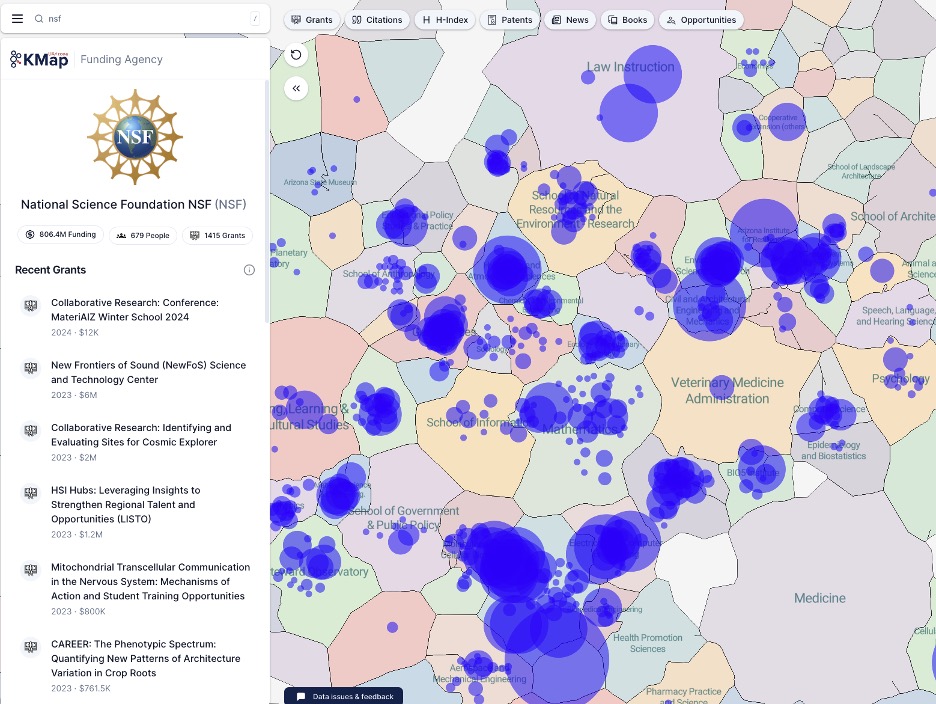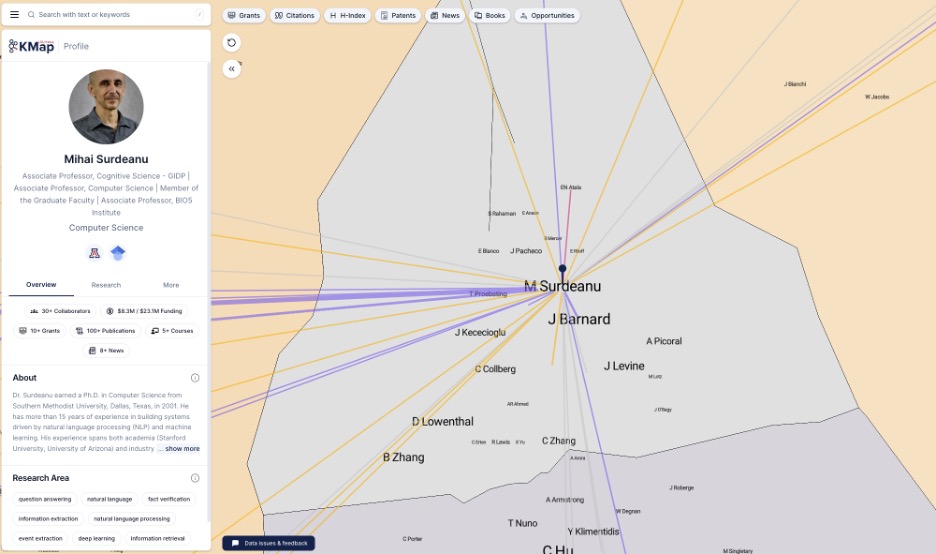Key points:
- A knowledge map collects research metadata and creates information visualizations
- Universities struggle to capture data’s value, study finds
- How to protect your institution’s student data
- For more news on research data, visit eCN’s Campus Leadership page
Research metadata is all around the University of Arizona campus, but the challenge is to collect, connect, analyze, and make it useful. The research metadata includes publications, proposals, grants, patents, courses, biographies of researchers, resumes, research projects, labs, etc. These are crucial to:
- Understand the university’s nature of internal and external collaborations
- Find internal experts in different areas of research
- Build a multidisciplinary team for a large project
- Collect and connect research activities
One of the success stories in building a knowledge map of the organization is the University of Arizona Knowledge Map (KMap). Here, we collect research metadata and develop useful systems by leveraging advanced algorithms on information visualizations, large language models, graph theory, and intelligent map systems. This article provides a glimpse of why your institution needs one and what you can do with the organizational knowledge map.
Through KMap, external entities, community members, and industry partners can identify research experts at the campus. Prospective students have the ability to search for professors with active grants in their desired research areas. Current students can discover research opportunities across the campus. Researchers and faculty members have control over their research profiles, showcasing their impacts and facilitating collaboration for future projects. Grant coordinators and support offices can locate university experts with specific research expertise or connections to companies, locations, or languages.
Administrators of the organization gain insight into the broader picture of the institution, understanding the impacts of faculty members, and more.
Building a bigger picture of the campus
There are numerous ways to enable users to navigate complex information, but the map metaphor has a special advantage – it can illustrate the bigger pictures as map overlays, and users can quickly navigate the knowledge map as a Google map. For instance, a weather heatmap for citations can efficiently guide users to important individuals cited within the organization, or display funding from the National Science Foundation. This approach enables the correlation of multiple pieces of information, such as how patent filings are connected to grants or citations received.

Figure 1: Department Overview, Researchers, and Associated Funding from the National Science Foundation (NSF)
Understanding campus collaboration
Extracting campus-wide collaborations is crucial for comprehending intra-research activities. Harvesting all metadata enables the construction of a collaboration network, encompassing not only co-authorship but also roles such as Principal Investigator (PI), Co-PI, sharing patents, or unsuccessful proposals. Incorporating an interactive interface aids in navigating this complex information. In Figure 2, we present an example of how a computer science professor collaborates with researchers from other departments.

Figure 2: Researcher Collaboration Network in the Knowledge Map with Profile Information
Expert search capabilities:
There are many challenges in finding internal experts in a large organization including data gaps, or algorithmic challenges, i.e. how to match experts. Those challenges include websites not updating, researchers moving to other organizations, or a non-uniform presentation of information. One can start with a Google search, a university website or department website, etc. But those definitely come with limitations and can be improved by building systems that connect with universities’ payroll databases to keep information current. For example: Find university experts in “Kidney Injury” in KMap.
A step forward to LLM for organizational needs
Advancing toward Large Language Models (LLM) for research metadata poses both exciting opportunities and considerable challenges. As everyone embraces the potential of LLM for their specific needs, the key lies in obtaining the right data to realize those aspirations. Establishing an organizational knowledge map enriched with extensive metadata serves as the initial and fundamental step in constructing an effective LLM. This process instills the confidence to pose intricate questions about the organization, such as identifying highly collaborative researchers on campus who have partnered with Kyoto University and secured funds from the Department of Defense.
This knowledge map system exemplifies the vision of campus analytics and leaders, leveraging research metadata to enhance the visibility of researchers and their activities. Explore more about the UArizona Knowledge Map (KMap) through the following resources:
- Videos about KMap
- How to Use KMap
- Discover the origins and purpose of KMap in the article Looking for University Experts and Research Collaborators? There’s a Map for That.
- Fully Homomorphic Encryption can revolutionize education - April 29, 2024
- Survey: More students want to go to graduate school - April 24, 2024
- Educause, AWS launch generative AI readiness assessment tool for higher ed - April 23, 2024

